Updated December 3, 2014: BriarTek’s patent claims relating to 2-way Satellite Emergency Notification Devices (SENDs) have been invalidated in a federal court ruling that granted summary judgement to Delorme. While the ruling makes interesting reading, if you are so inclined (Click here for links to the ruling download or viewing), the bottom line from District Court Judge Leonie Brinkema was that “all the asserted claims have been found to be invalid as a matter of law over the prior art, either as anticipated or as obvious,” and therefore BriarTek’s patent was invalid.
BriarTek’s patent claims threatened to strangle expansion and innovation is this increasingly popular distress beacon market. At best, the patent claims would increase the cost of the devices for consumers, which inevitably discourage purchase and their subsequent use to save lives.
Updated December 17, 2012: At the RTCM Board of Directors meeting last week, BriarTek delivered a letter stating that their patent was “not essential” and that it was possible to build a two-way SEND to the SC-128 standard without violating their patent. Discussion ensued and it was noted that in the opinion of at least one manufacturer present (and I concur), such a SEND would not be commercially viable since there would be little communication afforded without text, which is the essential part of the patent and essential to a commercially viable two-way SEND.
The conclusion was that while BriarTek was technically correct about it being “not essential,” in reality they were splitting very fine hairs. When I asked if they had amended their patent or planned to do so to encompass those alternative means, we were told by BriarTek’s representative at the meeting, Chuck Collins, that they had not done so and he couldn’t tell us if they planned to do so. BriarTek’s Intellectual Property attorney, John Fuisz, also attended.
In the end the Board determined that BriarTek had not violated the specific elements of RTCM’s Intellectual Property Policy, even if the general sentiment was that they had violated the spirit of the policy, and they decided not to invalidate and pull the SC-128 standard. Rather, they will revise the standard to incorporate a notice of BriarTek’s “not essential” patent.
This situation clearly exposed loopholes in the RTCM Intellectual Property Policy that was intended to prevent exactly this type of situation, where a party to the development of a standard could benefit financially from holding a patent essential to building devices that meet the standard. The Board took action to begin revising their Intellectual Property Policy to attempt to prevent the occurrence of such a situation again in the future.
With regards to the ITC complaint, I understand that Yellowbrick have capitulated and signed a licensing agreement with BriarTek. Given their very small market share and even smaller sales in the U.S. , that probably made sense from a purely financial perspective. I should note that doesn’t have any bearing on the validity of the patent.
I spoke to Delorme President Mike Heffron, who told me they had no intention of backing down. In an interesting turn of events, he told me that in a move initiated prior to the ITC complaint being filed, they will begin production in the U.S. very early in 2013. That would essentially nullify the ITC complaint, since the ITC ’s powers are limited to importation issues. At that juncture the ball is back in BriarTek’s court; they would need to file a lawsuit in Federal Court to continue their effort to enforce their patent.
Stay tuned. I somehow doubt this is the end of this story.
Updated October 10, 2012: BriarTek contacted me after this article was published and advised that they did have distribution and provided a list of 12 distributors for their Cerberus SEND. I requested that they provide links to the companies’ web sites, but they never responded to that request. With their help I was able to locate the product on REI’s web site and I independently located it on the SatPhoneCity USA web site, another of the listed distributors. The other distributors listed, most of which I was unable to locate with Google, appear to be strictly industry oriented operations, many of which are not located in the U.S., and clearly not consumer oriented U.S. businesses. That was the issue at hand in the article (below) regarding the claim that there was lack of distribution in the U.S. sufficient to replace, somehow, the existing widespread distribution of the targeted Delorme inReach, which if barred from sale would have an adverse effect on consumers.
I had hoped to visit BriarTek while I was in the D.C. area the week following publication of the article, at Joe Landa’s invitation, but was unable to do so due to unanticipated conflicts.
At the RTCM Board of Directors meeting in Orlando, there was considerable discussion of this issue. I arrived a few minutes late and then participated in that discussion. A Delorme representative attended the meeting. Joe Landa attended via conference call. BriarTek had indicated to the Board that in their opinion, their patent is not an “essential” patent. If this is the case then devices could be produced that meet the standard without infringing the Briartek patent. However, it could be that such devices would be far less commercially viable. RTCM requires any patents related to the standard to be declared. The difference between an “essential” patent and a “non-essential” patent is that RTCM does not publish standards that rely upon an essential patent. If the BriarTek patent is deemed “essential,” then it is possible the RTCM SC128 standard for SENDs might be withdrawn, which could create all sorts of problems.
The Board requested that BriarTek provide a letter that clearly stated whether they considered their patent to be essential or not, and why, and that they also include their proposed licensing requirements. Landa agreed to do so in a timely manner. The issue was then tabled until the next Board meeting in December, pending receipt of that letter. It was clear that not everyone on the Board agreed with the BriarTek position that their patent was non-essential.
September 6, 2012: On August 17, 2012, BriarTek IP, Inc. of Alexandria, Virginia, filed a complaint with the U.S. International Trade Commission (ITC) that alleges that Delorme’s and Yellowbrick’s 2-way Satellite Emergency Notification Devices (SENDs) infringe upon a BriarTek patent (U.S. Patent No. 7,991,380) and should be barred from importation. If their petition is granted, that would shut out Delorme’s popular inReach from U.S. consumers. Yellowbrick so far has only limited distribution, mostly in Europe, so that has limited direct impact on U.S. consumers.
BriarTek, Inc., a related company, licenses the BriarTek IP patent and manufactures and markets its Cerberus SEND and related smart phone applications and computer software.
By way of background, BriarTek filed a provisional patent application in March, 2006, for a “Global Bidirectional Locator Beacon and Emergency Communications System.” The patent was granted in August 2, 2011. It must be noted that grant of a patent doesn’t mean a patent is actually valid or enforceable, as many patents are later found to be invalid. The BriarTek patent is very broad in scope. It essentially claims invention of the entire concept of using satellites for 2-way text messaging distress beacons.
According to BriarTek President Joe Landa, BriarTek is simply interested in protecting its intellectual property and the investment it has made. He claims that he “doesn’t want to slow down release of any products into the market.” He explained that they had approached Delorme about licensing the patent prior to the filing and that is still BriarTek’s aim. He told me that he had extensive discussions with Delorme at the highest levels. “I offered Delorme a very reasonable license,” be said, but no agreement was reached. Yellowbrick was given 24-hour notice of the ITC filing. He explained that he “has long been a big proponent of getting these devices in the hands of the public,” and would “prefer to see more of them in use. ” Landa said in closing that he “cannot comment about any discussions either in the past or ongoing at this time that relate to the case or any potential settlements… We worked hard, we were awarded a patent, we hope others will respect our legal rights.”
This ITC complaint notice caught many in the industry by surprise. More on that later. Because of the very short eight-day timeframe provided for initial public comments on the complaint, only Delorme and Iridium filed comments (responses) opposing the complaint. (Click to read: Delorme Comments and Iridium Comments)
The ITC process is expedited compared to normal court proceedings. About 30 days after initial filing of the complaint, or in about one week, the ITC will institute the case (assuming all the legal requirements are met) and assign an administrative law judge (ALJ) to the case. The ALJ will set a target dates for the expedited process, which typically lasts from 9-18 months, but which can be extended. After motions and the like, the next big step will be an evidentiary hearing which is very similar to a federal trial. There is no option for a jury, the ALJ hears the case in accordance with administrative hearing rules.
After conclusion of the evidentiary hearing, the ALJ will issue an initial determination that is subject to review by the full Commission. At the stage they will publish a notice in the Federal Register seeking public comment on public interest issues and ALJ recommendations. That comment period is 30 days. Sixty days after notice is published the Commission will announce whether they will review the decision or not. At this juncture there’s another opportunity for the public to comment on public interest issues and ALJ recommendations If they chose not to review, the ALJ’s ruling becomes final. If reviewed, then they can reject the ALJ’s determination or modify it as they see fit. You can find an explanation for the ITC’s public interest accommodations here: http://usitc.gov/press_room/documents/featured_news/publicinterest_article.htm
Intellectual property is a key element in industrial development, but like anything given government sanction, patents can be abused. It is not uncommon for patent holders to demand licensing fees from existing commercial product manufacturers on patents. Then the issue becomes, is the patent is valid? The cost of challenging the patent must be weighed against the cost of litigation or paying a licensing fee. Certainly, those holding valid patents should expect to benefit from their efforts. If BriarTek’s patent claims are valid, it has every right to earn financial compensation for use of that patent.
If the patent is unquestionably valid, this is usually a fairly straightforward issue. After negotiations, the parties sign some form of licensing agreement and, typically, a royalty is paid to the patent holder. If there are issues with patent validity or if the demands for fees are outrageous, then the next step is typically either a request to re-evaluate the patent on the part of those accused of infringement , more on that later, or a lawsuit is filed by the patent holder where a judge or jury will eventually determine patent validity, damages and the like. Depending on how things are proceeding, a settlement may reached that resolves the issue, one way or another, prior to either effort coming to a conclusion.
When the alleged infringing product is imported, as is the case here, then the ITC can become another venue for the patent holder to assert pressure. Landa is quite clear that this is their goal, to pressure the parties to compensate them for use of their patent. And, he claims, “this is a less onerous process because it cannot reach back for damages and other claims.”
Anyone reading headlines about the patent battles occurring in the cell phone/smart phone/tablet wars will have some understanding of the stakes and the costs involved in protecting intellectual property.
Reading the Delorme Comments and Iridium Comments, they make the case that this ITC complaint should be rejected by the ITC due to the public interest issues alone, which are a significant area of concern for the ITC, as noted above. In their comments they assert that many of BrairTek’s claims of injury don’t hold water and that there is little question that consumers would be the losers.
A few weeks ago at Outdoor Retailer Summer Market, I spoke with Landa about the Cerberus SEND and he specifically said their primary emphasis was on government and corporate markets. Given the relatively high cost of their Cerberus SEND, up to three times more than the inReach, that made a lot of sense. Their primary existing product line is comprised of Man Overboard Beacons and systems that are, likewise, primarily sold direct to the military and commercial/industrial market. They currently have no significant presence in the consumer marketplace. Cerberus is only available online from their own web site.
As Delorme points out in their filing, there appears little likelihood that BriarTek could fill the existing consumer market niche, and certainly not in a reasonable timeframe, due to their much higher price and limited manufacturing capacity as well as virtually no presence in the consumer marketplace. There is also little evidence that these other 2-way SENDs are actually harming BriarTek. Most critically, they claim that a decision in BrairTek’s favor could put lives at stake.
If the ITC decides on BriarTek’s behalf, it is certainly possible that, absent some licensing or other scheme being implemented, consumers will take a hit and a growing market in advanced 2-way SENDs will be nipped in the bud until it sorts itself out. That could take considerable time, perhaps years if Delorme decides to fight rather than come to some sort of financial agreement with BriarTek.
These 2-way SENDS offer significant advantages to someone in an emergency situation and the Search and Rescue community, alike, compared to traditional 1-way alerting, albeit this comes at a cost increase. So, it’s not for everyone. Having said that, this same communications capability in non-distress situations can make them much more appealing than a more simplistic distress beacon or SEND. That helps to drive sales.
Text communications are inherently less costly and more compact compared to voice communications capability. As such, the uptake by consumers will be far greater for a 2-way text device compared to a satellite phone. The more competition there is in this market, the better it is for consumers and the SAR community as more of these devices will end up in the hands of those in need. That will result in more lives saved and fewer SAR responders put at risk.
BriarTek has certainly got Iridium’s attention, evidenced by their comments. Iridium has worked hard the past few years promoting 2-way SENDs and encouraging companies to enter the market. I am aware of numerous such devices in the works. Iridium sells modems and satellite data plans, so the more SENDs, the better from their viewpoint. Iridium is the 800-pound gorilla in the room. Without the Iridium satellite system, BriarTek is pretty much out of business. While it may not be able to cut BriarTek off “for cause” over this effort to monetize their patent, Iridium can certainly make their life difficult and could easily choose not to renew their agreement when the time comes.
Neither Delorme nor Iridium were willing to comment further due to the pending legal action, for the time being letting their public interest comments on the complaint stand on their own. Other companies with 2-way SEND devices in the works declined to go on the record. I can characterize their off-the-record comments as disdainful of BriarTek’s patent claims.
Beyond SENDs, if the patent was held to be valid, this could potentially impact the Next Generation COSPAS-SARSAT (MEOSAR) system which is currently in development with satellites and systems already being tested. That internationally supported distress alerting system allows for optional 2-way messaging incorporated into next generation 406 MHz EPIRBs, ELTs and PLBs.
There is also another issue, which may or may not bear on the legal side, but needs disclosure since this potentially affects many new SENDs in the pipeline and these devices are all about saving lives. The more SENDs out there, the more lives saved.
BriarTek, in its manufacturer guise, is a member of RTCM (Radio Technical Committee for Maritime) http://www.rtcm.org/ and Joe Landa was an active participant in the RTCM SC128 Special Committee that developed the SEND standard. That effort started in December, 2008, with the new standard being voted on in March, 2011, passing in May, http://www.equipped.org/blog/?p=331 and it was formally adopted on August 1, 2011. The FCC is a participant in RTCM committees and this SC128 standard has been forwarded to the FCC to be incorporated into FCC regulations. Delorme, as manufacturer of the inReach that was not yet released at the time that SC128 started work, was also a participant in the SC128 committee. Delorme’s current Vice President and General Manager, Patrick Shay, was employed by Iridium during that time period and was Iridium’s representative on the SC128 committee. He was also active in promoting 2-way SENDs via the ProTECTS Alliance (standing for Promotion of Two-way Emergency Communication and Tracking Systems) that Iridium initiated.
While the primary motivation for developing the SC128 standard was to protect consumers and ensure these devices work in emergency situations by setting a minimum level of performance, similar to the SC110 PLB standard, there’s no question that the SEND standard provided financial benefits to manufacturers. It essentially makes their conforming products more marketable and valuable.
RTCM has a long established policy that it “develop standards that do not require the use of patented technologies as the only means to comply with a standard (essential patents)” and that “Members of RTCM Special Committees and members of the RTCM Board of Directors should identify patented elements they are aware of which are included in any standard in preparation or revision.” In addition, “The ballot to approve every RTCM standard shall ask the member to identify any applicable patents they are aware of which are not identified in the standard.”
Having participated in SC128 meetings from the start, I can testify that I do not recall Landa ever once mention BriarTek’s pending patent, which would clearly be deemed an “essential patent” for any 2-way SEND. Checking with other SC128 members, nobody else that I spoke with recalls any such disclosure. Having said that, Landa claims that he recalls advising SC128 “that we had pending patents in this area. In general I do not comment on specific patents that are pending. I had no way at that time of knowing what claims would or would not be allowed or even if the patent would ever be awarded.”
Also, RTCM confirms that Landa did not vote on the standard, which may have required he disclose the patent on his ballot. I say “may,” because the patent at that time was still pending and the plain wording of the RTCM policy applies to issued patents. The consensus of those SC128 members I spoke with, who declined to be quoted on the record, is that Landa chose to not disclose a pending patent that could potentially affect many SEND manufacturers while he participated in developing a standard with many of those same manufacturers that could thereby enrich his company if he was awarded the patent and the patent is found to be valid.
It must be noted that while it appears that nobody else in the room was aware of the pending patent except Landa, at least those I spoke with, the patent application process is not confidential and patent applications are publicly available, with this patent application published October 7, 2007. Whether the other manufacturers at the table ought to have done a better job of keeping an eye on patent applications relating to their existing or potential products is another issue altogether.
The RTCM Board of Directors will take up this issue at their meeting the last week in September.
Consistent with Landa’s remarks to me, the assumption on the part of most I spoke with in the industry is that BriarTek’s ultimate goal is to license the patent or achieve some other form of financial settlement, which would give it a steady income stream from every 2-way SEND sold or a lump sum payment or something along those lines. The ITC action then is viewed as a way to assert pressure towards such an agreement. If a major player like Delorme signs, others would typically follow. That could take the validity of the patent out of play. The validity of the patent is the crux of the matter.
At this point, beyond dealing with the pending ITC complaint or acceding to BriarTek’s demands, Delorme certainly has the option of either requesting a re-examination of the patent due to documented prior art (meaning documentation that this capability covered by the patent existed or was discussed in some public forum prior to the patent application date) or filing a court challenge against BriarTek over the infringement claim that is contained in the ITC complaint. On balance, the expedited ITC process is likely its best choice. Note, however, that even if the ITC rules against BriarTek, including if it finds the patent to be invalid, that decision does not actually invalidate the patent and BriarTek could still file a lawsuit in Federal District Court. Not typically an effective strategy according to my sources, but…
With regards to the validity of that patent, ETS Foundation Board of Directors member, Scott Weide, an intellectual property attorney, provided this considerably simplified explanation of the issues:
The BriarTek patent claims some fairly broad concepts. For example, Claim 1 is generally directed to an emergency monitoring system which includes a user satellite communication device which communicates with a monitoring system via a satellite network, incorporates a GPS device, and where the user device includes a text entry device which is adapted to receive textual data entered by the user. During review of the patent, BriarTek argued that the feature of the user device having a text entry device adapted to receive textual data rendered the system unique over the prior art. The breadth of this claim certainly makes it subject to an invalidity attack.
While the U.S. Patent Office did not locate any prior art specifically disclosing a satellite communication system which allowed a user to input text, such prior art may still exist (in other literature or use not located by the Patent Office) such that the invention claimed in Claim 1 is not novel under U.S. patent laws (as we note below, it appears that could be the case – DR).
In addition, the claims of the BriarTek patent may be invalid based upon obviousness. Under Section 103 of the U.S. patent laws, a claimed invention is obvious, and thus not patentable, if the differences between the claimed subject matter and the prior art are such that the subject matter as a whole would have been obvious at the time the invention was made to a person having ordinary skill in the art to which said subject matter pertains (in other words, if someone knowledgeable regarding the subject would consider the invention an obvious next step, it isn’t patentable – DR).
BriarTek admits that satellite distress communication systems incorporating GPS which did not have text input/transmission functionality existed at the time of the invention. At the same time, user communication devices with text entry features and the ability to transmit textual data over a communication system were well known in other communications systems (beepers, cellular phones, etc.). Thus, although satellite distress communications systems may not have been implemented specifically with text transmission capabilities, it doesn’t appear to be because the feature wasn’t within the knowledge of one of ordinary skill in the art. In fact, it would be obvious to just about anyone that it was just a matter of time before that capability would be implemented via satellite.
One example of prior art may be found in the Distress Alerting Satellite System (DASS) which was seen as the next generation of distress system, building on the first generation COSPAS-SARSAT 406 MHz system. Many of the DASS concepts have evolved into the COSPAS-SARSAT Next Generation (MEOSAR) System. DASS originated back in 1998 and in February 2003, NASA, NOAA, the USAF, the USCG, and the DOE signed a Memorandum of Agreement regarding DASS development and demonstration. From the start, 2-way messaging was a key element of DASS. A published DASS document notes “the system also has the potential of providing additional one-way or two-way, non-vocal digital messaging.” Clearly, this predates the BriarTek patent submission.
Another example of a system that appears to have incorporated all the elements of the patent claims in prior art is the Volvo SeaKey system, first deployed in the early 2000’s. This maritime system uses the Orbcomm satellite system to provide tracking and distress alerting and response via text.
At this point there are a lot of accusations being flung around, often contradictory. Ultimately, I think this will resolve itself, either because the patent is invalidated or a settlement is reached on licensing terms if the patent looks to held up as valid.
Speaking to industry members, who spoke to me on condition of confidentiality, it seems clear that BriarTek’s patent will be challenged with support from at least most of those potentially affected. The cost to both parties, BriarTek and those opposed to this action and the validity of the patent, will be high, no matter the outcome. That will inevitably be reflected in the price of these SENDs.
Stay tuned for further developments.
Updated December 3, 2014: BriarTek’s patent claims relating to 2-way Satellite Emergency Notification Devices (SENDs) have been invalidated in a federal court ruling that granted summary judgement to Delorme. While the ruling makes interesting reading, if you are so inclined (Click here for links to the ruling download or viewing), the bottom line from District Court Judge Leonie Brinkema was that “all the asserted claims have been found to be invalid as a matter of law over the prior art, either as anticipated or as obvious,” and therefore BriarTek’s patent was invalid.
BriarTek’s patent claims threatened to strangle expansion and innovation is this increasingly popular distress beacon market. At best, the patent claims would increase the cost of the devices for consumers, which inevitably discourage purchase and their subsequent use to save lives.

 Is it irony or hubris that the music the promoter chose for the promotional video accompanying the campaign is the original theme from Mission Impossible? That video is a mash-up of scenes from a number of PLB and SEND promotional videos and Search and Rescue videos, including many from Breitling EMERGENCY videos. The Breitling EMERGENCY is the only available PLB watch you can purchase in the U.S. with a $16,000 +/- MSRP. (Disclaimer: Equipped To Survive Foundation supported the waiver of certain normally required PLB specifications required for the FCC to certify the EMERGENCY for sale in the U.S.)
Is it irony or hubris that the music the promoter chose for the promotional video accompanying the campaign is the original theme from Mission Impossible? That video is a mash-up of scenes from a number of PLB and SEND promotional videos and Search and Rescue videos, including many from Breitling EMERGENCY videos. The Breitling EMERGENCY is the only available PLB watch you can purchase in the U.S. with a $16,000 +/- MSRP. (Disclaimer: Equipped To Survive Foundation supported the waiver of certain normally required PLB specifications required for the FCC to certify the EMERGENCY for sale in the U.S.) Only one other PLB “watch” has received COSPAS-SARSAT approval, the chunkier and decidedly unfashionable SAT406 by Mobit Tekecom, but it doesn’t have a 121.5 MHz homing signal, doesn’t have FCC approval and isn’t available for purchase. While aiming to be more affordable than the Breitling, it might be better described as a wrist-worn PLB with auxiliary digital watch functions. Currently, conventional PLBs that are easier to engineer, certify and manufacture start in the low $200 range in a very competitive market.
Only one other PLB “watch” has received COSPAS-SARSAT approval, the chunkier and decidedly unfashionable SAT406 by Mobit Tekecom, but it doesn’t have a 121.5 MHz homing signal, doesn’t have FCC approval and isn’t available for purchase. While aiming to be more affordable than the Breitling, it might be better described as a wrist-worn PLB with auxiliary digital watch functions. Currently, conventional PLBs that are easier to engineer, certify and manufacture start in the low $200 range in a very competitive market. So, just the testing and certifications required to sell in the U.S. will cost far more than the meager $25,000 budgeted. And, the odds of getting it done by December of this year are zero.
So, just the testing and certifications required to sell in the U.S. will cost far more than the meager $25,000 budgeted. And, the odds of getting it done by December of this year are zero.

 The Titan high beam provides a quite adequate 125 lumens, but the Titan Plus puts out an impressive 300 lumens of what I’ll call
The Titan high beam provides a quite adequate 125 lumens, but the Titan Plus puts out an impressive 300 lumens of what I’ll call The Titan’s 125 lumen high output is rated at 1 hour and it lasted 40 minutes before dropping precipitously.
The Titan’s 125 lumen high output is rated at 1 hour and it lasted 40 minutes before dropping precipitously.  Which brings us to another feature that separates these lights from most other pocket-sized EDC flashlights, the beam itself. This innovation is courtesy of the patent pending multi-faceted reflector that creates what Surefire is calling a "MaxVision Beam." There have been a variety of attempts to create smooth and wide light (flood) from high-output LEDs, whether single focus or via a zoom mechanism, primarily using a lens and occasionally with some reflector technology. Some have been better than others, but the majority have not been particularly compact and most have been less than impressive.
Which brings us to another feature that separates these lights from most other pocket-sized EDC flashlights, the beam itself. This innovation is courtesy of the patent pending multi-faceted reflector that creates what Surefire is calling a "MaxVision Beam." There have been a variety of attempts to create smooth and wide light (flood) from high-output LEDs, whether single focus or via a zoom mechanism, primarily using a lens and occasionally with some reflector technology. Some have been better than others, but the majority have not been particularly compact and most have been less than impressive.  The change to brass ups the weight to 2 ounces, a very noticeable difference. While it also has an integral tailcap post, it comes with quick-detach plastic tailcap (that adds 0.1 ounces) with split ring that fits over the end so it’s relatively easy to get it on or off a keychain when you need to. A good yank or levering the cap off to the side separates the cap from the light. In my opinion, at nearly 2 ounces it’s a bit too heavy for a keychain light for most folks. So, it’s a good thing that it also comes with a removable pocket clip.
The change to brass ups the weight to 2 ounces, a very noticeable difference. While it also has an integral tailcap post, it comes with quick-detach plastic tailcap (that adds 0.1 ounces) with split ring that fits over the end so it’s relatively easy to get it on or off a keychain when you need to. A good yank or levering the cap off to the side separates the cap from the light. In my opinion, at nearly 2 ounces it’s a bit too heavy for a keychain light for most folks. So, it’s a good thing that it also comes with a removable pocket clip.  I really liked having the triple mode option with that really bright high beam for the occasional times it comes in handy, and the mid-range 75 lumen output for general use, but I really wanted it as a keychain light. I wondered what would happen if I fitted the Titan Plus head (and 900 mAh battery) to the Titan aluminum body? That combination weighs in at 1.3 ounces, a significant reduction in weight, relatively, putting the "Franken-Titan" back into keychain weight territory, in my opinion.
I really liked having the triple mode option with that really bright high beam for the occasional times it comes in handy, and the mid-range 75 lumen output for general use, but I really wanted it as a keychain light. I wondered what would happen if I fitted the Titan Plus head (and 900 mAh battery) to the Titan aluminum body? That combination weighs in at 1.3 ounces, a significant reduction in weight, relatively, putting the "Franken-Titan" back into keychain weight territory, in my opinion. 
 The somewhat intricate links are precision manufactured using a Metal Injection Molding (MIM) process. Compared to the typical 300-series stainless typically used in jewelry, watch bands and the like, the 17-4 stainless steel can be heat treated to harden the steel so it will hold up to the rigors and abuse the tools will see. The bracelet is available in either natural stainless steel or with a DLC (Diamond-Like Coating) black finish.
The somewhat intricate links are precision manufactured using a Metal Injection Molding (MIM) process. Compared to the typical 300-series stainless typically used in jewelry, watch bands and the like, the 17-4 stainless steel can be heat treated to harden the steel so it will hold up to the rigors and abuse the tools will see. The bracelet is available in either natural stainless steel or with a DLC (Diamond-Like Coating) black finish. Final judgment is in on ACR’s lawsuit against DME and its design consultants alleging that they misappropriated ACR trade secrets and documents and incorporated them into DME’s SATRO PLB. In a Stipulated Judgment and Permanent Injunction issued on January 15, 2013, DME lost big time.
Final judgment is in on ACR’s lawsuit against DME and its design consultants alleging that they misappropriated ACR trade secrets and documents and incorporated them into DME’s SATRO PLB. In a Stipulated Judgment and Permanent Injunction issued on January 15, 2013, DME lost big time. The past few weeks have seen a significant uptick in emails to me expressing concern about possible rioting as a result of the upcoming election, asking what the writer should do to protect themselves (a subject also being discussed on a number of online forums). If anything is a sad commentary on the current political situation, this certainly is.
The past few weeks have seen a significant uptick in emails to me expressing concern about possible rioting as a result of the upcoming election, asking what the writer should do to protect themselves (a subject also being discussed on a number of online forums). If anything is a sad commentary on the current political situation, this certainly is. 
 Turns out that just days before I published my initial report on the SATRO,
Turns out that just days before I published my initial report on the SATRO, 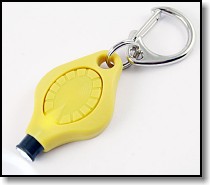 There’s no excuse not to always have a flashlight with you with the proliferation of compact LED flashlights.
There’s no excuse not to always have a flashlight with you with the proliferation of compact LED flashlights. 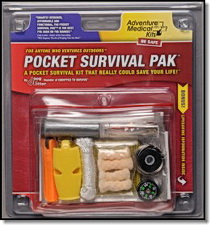 For a compact survival headlamp, having a switch that cannot readily be inadvertently switched on in storage, the
For a compact survival headlamp, having a switch that cannot readily be inadvertently switched on in storage, the 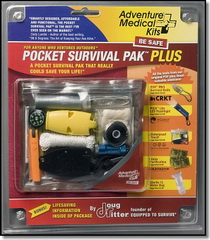 I always carry at least two, and usually three, means to start a fire. It is really that important. Besides a compact lighter, reliable matches are a good choice. For many years I have recommended
I always carry at least two, and usually three, means to start a fire. It is really that important. Besides a compact lighter, reliable matches are a good choice. For many years I have recommended  My
My 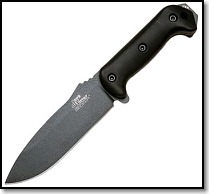 The second run of my
The second run of my  My
My 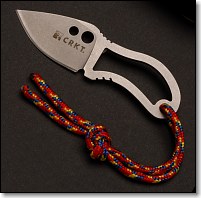 If a very compact knife to fit in a survival kit is what you are looking for, I suggest you consider my
If a very compact knife to fit in a survival kit is what you are looking for, I suggest you consider my  For well under $300 you can get a 406 MHz Personal locator Beacon (PLB) with integral GPS that is about the size of many cell phones, weighs less than 5 ounces and easily fits in your pocket. With a simple press of a button your distress alert is sent out through the international COSPAS-SARSAT distress satellites and help will be quickly on its way. There is no recurring charge or subscription and the battery has a replacement interval of 6 years (by which time it will be smaller and cheaper, so you won’t replace the battery anyway).
For well under $300 you can get a 406 MHz Personal locator Beacon (PLB) with integral GPS that is about the size of many cell phones, weighs less than 5 ounces and easily fits in your pocket. With a simple press of a button your distress alert is sent out through the international COSPAS-SARSAT distress satellites and help will be quickly on its way. There is no recurring charge or subscription and the battery has a replacement interval of 6 years (by which time it will be smaller and cheaper, so you won’t replace the battery anyway). 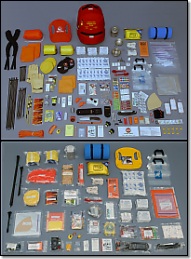 Saving the best for last, I offer up the
Saving the best for last, I offer up the